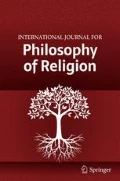Notes
See William Alston, ‘The elucidation of religious statements’, inProcess and Divinity: The Hartshorne Festschrift (La Salle, Ill.: Open Court, 1964). Also seePhilosophy of Language (Englewood Cliffs, N.J.: Prentice-Hall, 1964). Alston's work on Whitehead includes ‘Whitehead's denial of simple location’,Journal of Philosophy 48 (1951): 713–720; ‘Internal relatedness and pluralism in Whitehead’,Review of Metaphysics 4 (1952): 535–558.
See Thomas McFarland,Coleridge and the Pantheist Tradition (Oxford: Clarendon Press, 1969), p. 127.
See Alston's ‘Hartshorne and Aquinas: A Via Media’, in John Cobb and Franklin Gamwell (eds.),Existence and Actuality (Chicago: University of Chicago Press, 1984); also found in Alston'sDivine Nature and Human Language (Ithaca: Cornell University Press, 1989).
Charles Hartshorne, ‘An outline and defense of the argument for the unity of being in the Absolute or Divine Good’, (Ph.D. Dissertation, Harvard University, 1923), p. 13.
Hartshorne, ‘An outline and defense ⋯ ’, pp. 26, 49.
See my ‘BeingIs Power’, forthcoming.
See Henri Bergson,Creative Evolution, translated by A. Mitchell (New York: Holt, 1911); originally published in 1907. AndThe Two Sources of Morality and Religion, translated by Brereton (Notre Dame: University of Notre Dame Press, 1977); originally published in 1932. In addition to Plato and Bergson, Hartshorne cites Milton Munitz regarding the impossibility of absolute nothingness. SeeThe Mystery of Existence (New York: Appleton-Crofts, 1965).
Charles Hartshorne,Creative Synthesis and Philosophic Method (La Salle, Ill.: Open Court, 1970), pp. 21–57, 245, 283.
Hartshorne, ‘An outline and defense⋯’, p. 115.
See my ‘Does God have a body?’,The Journal of Speculative Philosophy 2 (1988): 225–232.
See Richard Creel,Divine Impassibility (Cambridge: Cambridge University Press, 1986).
Lewis Ford, ‘The non-temporality of Whitehead's God’,International Philosophical Quarterly (1974). Also see Ford's ‘Whitehead's differences from Hartshorne’, in Lewis Ford (ed.),Two Process Philosophers (Tallahassee, Fl.: American Academy of Religion, 1973). Ford's view is more complex than Alston indicates. At times Ford has agreed with Alston and at times Ford has agreed with something like Hartshorne's view: God is to be conceived in terms of an unending series of successive temporal unifications of the world.
Rem Edwards, ‘Kraus's Boethian interpretation of Whitehead's God’,Process Studies 11 (1981): 30–34. Also see Elizabeth Kraus,The Metaphysics of Experience: A Companion to Whitehead's Process and Reality (New York: Fordham University Press, 1979).
Edwards, p. 34.
See Cobb and Gamwell,Existence and Actuality, p. 99, for this quotation from Hartshorne.
Cobb and Gamwell, pp. 100–102. Also see the volume in The Library of Living Philosophers Series titledThe Philosophy of Charles Hartshorne, ed. by Lewis Hahn (LaSalle, Ill.: Open Court, 1991). My article in this volume is on ‘Hartshorne and Plato’.
Author information
Authors and Affiliations
Rights and permissions
About this article
Cite this article
Dombrowski, D.A. Alston and Hartshorne on the concept of God. Int J Philos Relig 36, 129–146 (1994). https://doi.org/10.1007/BF01316920
Issue Date:
DOI: https://doi.org/10.1007/BF01316920

